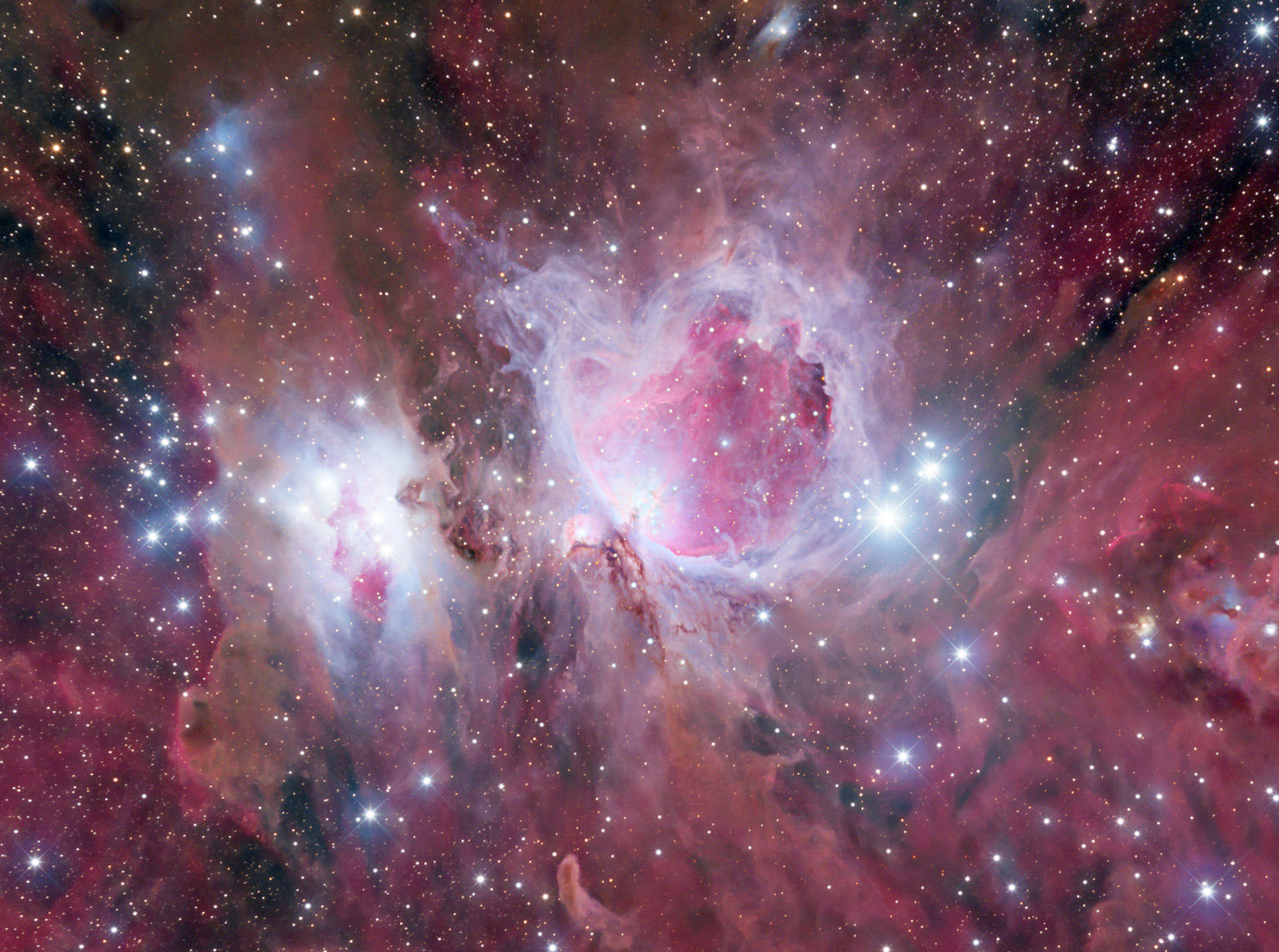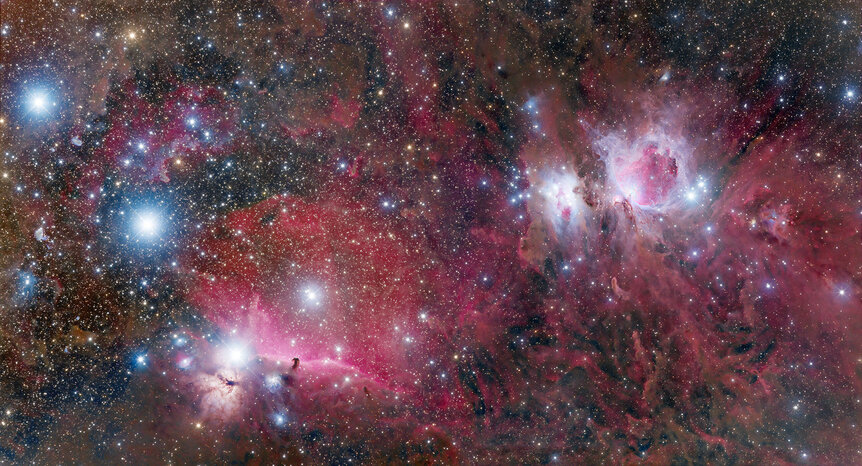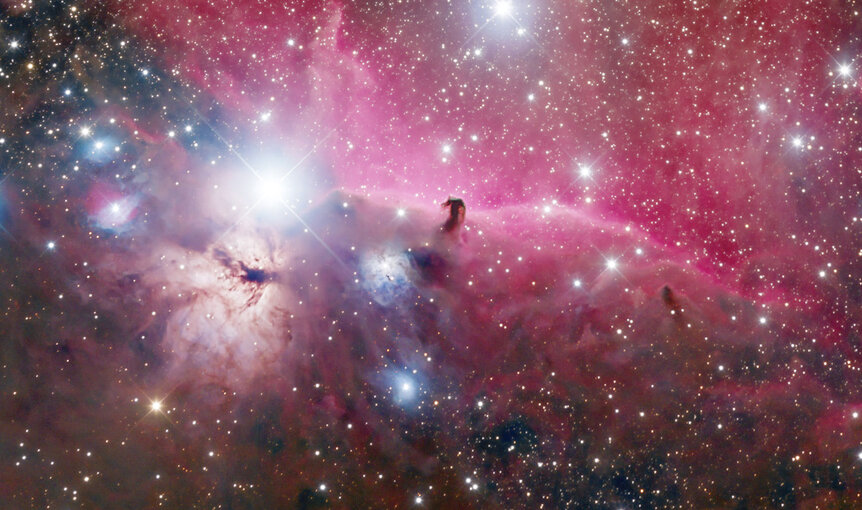Create a free profile to get unlimited access to exclusive videos, sweepstakes, and more!
A Block of Orion

[Note: This article is written with my Northern Hemisphere bias. If you live south of the equator, turn your monitor upside down to read it.]
For me, there is no surer sign of winter coming than seeing Orion rise over the eastern horizon shortly after sunset.
And yeah, I know that this article is posting in July (in fact the day after the Fourth, the canonically most summery of all U.S. holidays), but that doesn't mean Orion isn't still there. It literally rises with the Sun right now, but it's out there.
And with so much of the world so much hotter than usual, maybe a little reminder of cooler days — and nights — will be welcomed. So please, feast your eyes on a blast of winter … Orion, or at least a piece of it:
Whoaaaaa. And yeah, I had to shrink it to fit the blog. You may be interested in the larger 4,600 x 2,500 pixel version of it to illuminate your eyeballs.
This image comes courtesy of my friend and astronomer Adam Block, who took it using a truly drool-inducing Takahashi E-180, a magnificent 'scope designed to take images of wide areas of the sky — each image is a huge 4.5° on a side, wide enough to fit 9 full Moons!
Or, in this case, a big chunk o' Orion. Specifically, from his belt down to below his "dagger." The image is "sideways" compared to how you normally think of Orion. The three stars making up the belt are on the left (Alnitak, Alnilam, and Mintaka, from bottom to top) and the dagger to the right. It’s a lot of sky; in fact this is a mosaic of two panels, and it's roughly 8° long (there was probably some overlap between the frames that Adam stitched together).
The Orion Nebula, one of the closest large star-forming regions in the galaxy. Credit: Adam Block/Steward Observatory/University of Arizona
On the upper right is the iconic and ridiculously spectacular Orion Nebula, a star-forming factory that is cranking out a lot of stars. It’s actually part of the far larger Orion Molecular Cloud Complex, a huge dark and cold cloud of gas and dust. A handful of the most massive and luminous stars born there are near the edge of that cloud, and their ultraviolet light has eaten away at the cloud. This created a cavity, then a blister, then a blowout, popping the wall of the cloud so we can see the stars inside. I love images like Adam’s here, because you can see that the body of the Orion Nebula is actually a cavity, like a scoop taken out of the cloud.
At the bottom left is a nebula just as iconic: The Horsehead, named for obvious reasons. In this case the nebula is something of the opposite of the Orion Nebula, since it's a dark cloud superposed on a bright one. Stars are forming inside there, too. If you follow the neck and head of the Horsehead up, you'll see a bright star shining light directly down on it. That star, Sigma Orionis, is blasting the cloud below, and is what's forming the horsehead shape. To the left of the Horsehead is the Flame Nebula, too. I've written about this in detail before for another gasp-worthy wide-field shot of this region, if you want more info.
As for the rest of this image, it's littered with hydrogen gas glowing red, dust reflecting the blue light from massive stars, and dark clouds that have somehow avoided the chaos of radiation and heat going on around them.
I've said this before, but when you’re outside with binoculars or a telescope, there's no wrong place in Orion to look. You need a photo to see this much detail, but heck, the Orion Nebula is visible to the naked eye! So binoculars are a good place to start.
Of course, you'll have to wait a few months … or you could have a go at the Scorpius/Sagittarius area of the sky, which is above the southern horizon once the sky is fully dark (look for Jupiter right now, which is hard to miss; it's near the red eye of the scorpion, Antares, for the moment). When you look that way you're looking downtown, toward the center of our galaxy, and there are treasures there to keep you busy for quite some time.
Or, y'know, just take in the whole sky. Go out under the stars if you're able, and just experience the Universe. I'm all for that too.

















